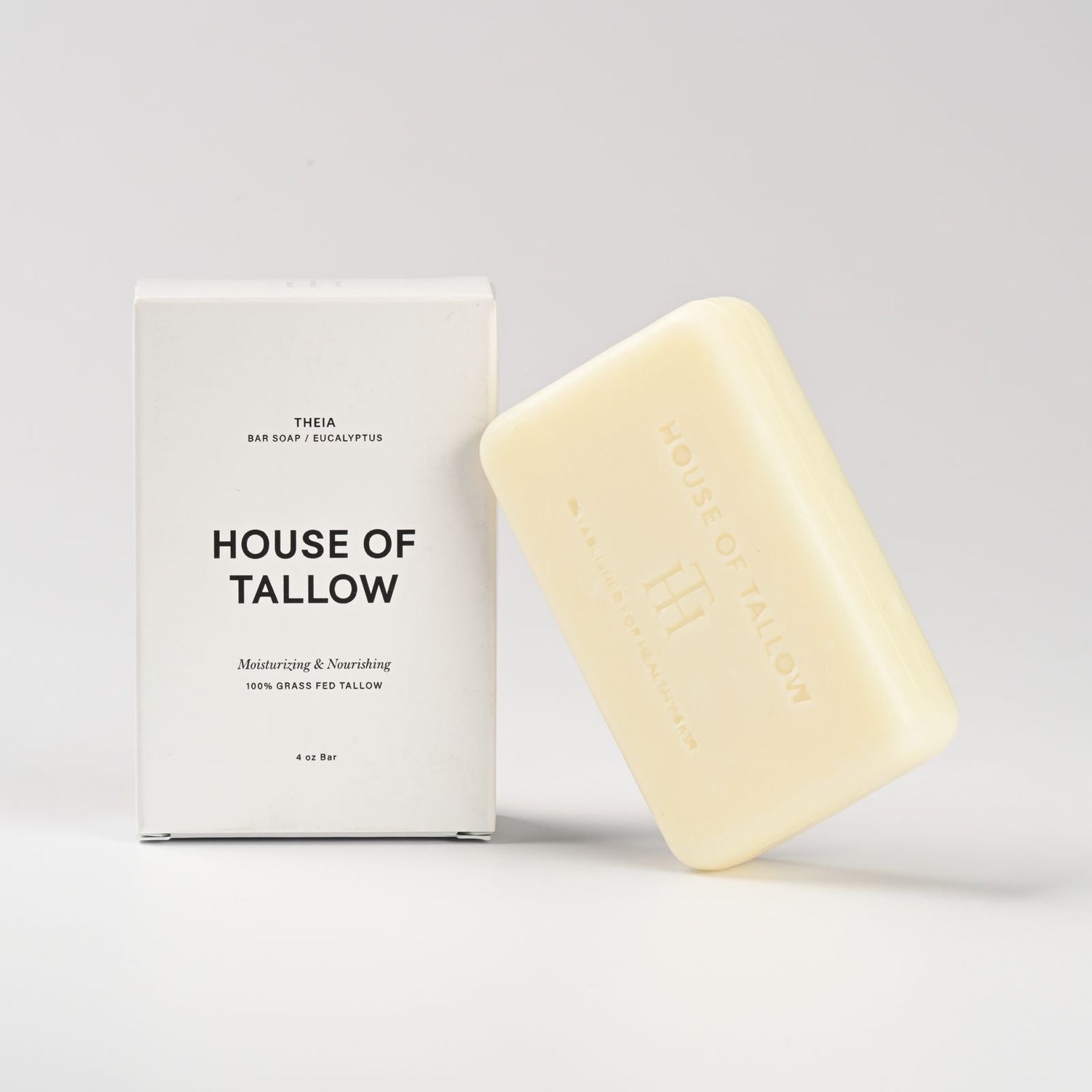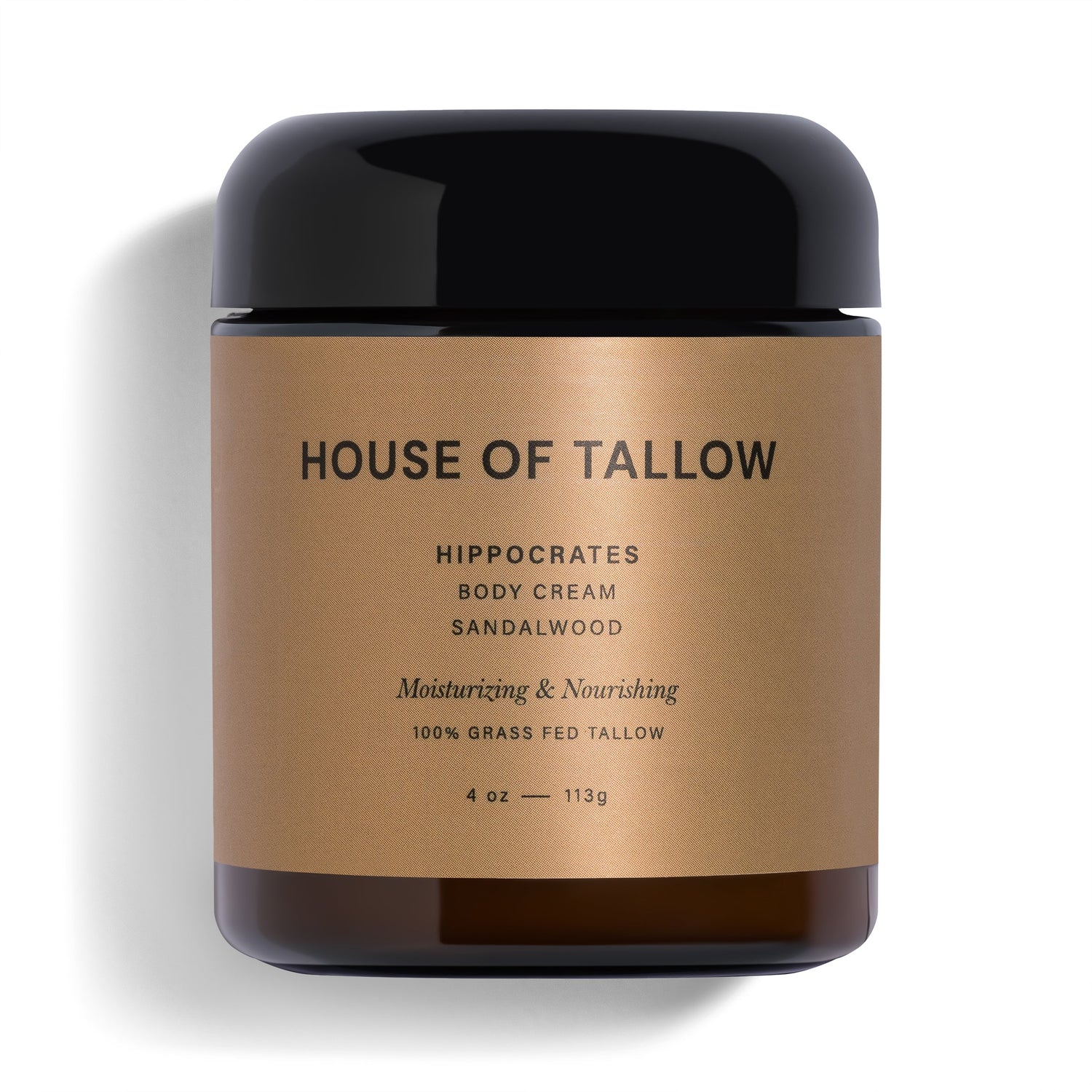Choosing between tallow-based and chemical-based skincare? Here's what you need to know:
- Tallow Skincare: Uses grass-fed animal fat, rich in vitamins A, D, E, and K. Mimics human skin's natural oils for hydration and barrier repair. Minimal processing, fewer ingredients, and biodegradable.
- Chemical-Based Products: Designed for targeted results with synthetic ingredients like silicones and preservatives. Longer shelf life but may cause irritation and environmental concerns.
Quick Comparison
| Feature | Tallow-Based Products | Chemical-Based Products |
|---|---|---|
| Ingredients | Grass-fed tallow, essential oils | Synthetic compounds, preservatives |
| Hydration Boost | 35% (4 weeks) | 22% (4 weeks) |
| Allergy Risk | Minimal | Higher |
| Environmental Impact | Low (biodegradable, eco-friendly) | High (waste, pollution) |
| Shelf Life | Shorter | Longer |
Key Takeaway: Tallow-based products are natural and eco-friendly, great for sensitive skin. Chemical-based options offer quick, targeted results but come with more risks and environmental drawbacks.
Is Beef Tallow Good for Your Skin? Dermatologist Breaks Down the Facts
Ingredients and Composition
The main distinction between tallow-based and chemical-based skincare products lies in their ingredients and how they are formulated. These differences align with consumer concerns about safety and eco-consciousness mentioned earlier.
Tallow Skincare: Natural Ingredients
Tallow-based skincare products rely on grass-fed tallow as their main ingredient. Its molecular structure is very similar to human sebum, which helps with moisture retention and skin compatibility. Dermatologist Dr. Sarah Johnson explains:
"Tallow closely mimics the skin's natural sebum, making it an excellent moisturizer that doesn't disrupt the skin's natural processes." - Dr. Sarah Johnson, Dermatologist
Chemical-Based Products: Synthetic Ingredients
Chemical-based skincare products are made with a variety of synthetic ingredients, each serving specific purposes. Common components include:
- Silicones for improving texture
- Phthalates to stabilize fragrances
- Ethanolamines for balancing pH levels
- Synthetic preservatives to extend shelf life
Comparison Table: Ingredients
| Characteristic | Tallow-Based Products | Chemical-Based Products |
|---|---|---|
| Key Components | Grass-fed tallow, essential oils, natural vitamins | Synthetic compounds, preservatives, artificial fragrances |
| Nutrients | Natural vitamins A, D, E, K, fatty acids | Isolated or synthetic active ingredients |
| Preservation Method | Natural preservation, shorter shelf life | Chemical preservatives, longer shelf life |
| Ingredient List Length | Typically 5-10 ingredients | Often 20+ ingredients |
| Biocompatibility | High (similar to skin's natural oils) | Varies by formulation |
The clear difference in ingredients reflects two distinct approaches to skincare. Tallow-based products prioritize minimal processing and natural compatibility, while chemical-based options focus on engineered solutions tailored to specific skin issues. Interestingly, a study found that 85% of conventional personal care products contain at least one chemical that may affect hormones [1].
These contrasting philosophies also influence how these products perform on the skin, a topic we'll explore in the next section: Skin Benefits and Effectiveness.
Skin Benefits and Effectiveness
Looking at ingredient composition, comparing how effective these approaches are reveals some key differences.
Tallow Skincare: Hydration and Compatibility
Studies show that tallow-based skincare products can provide noticeable relief and hydration. For example, clinical trials found that 85% of eczema patients reported relief within just two weeks of using tallow-based balms. Another study published in the Journal of Cosmetic Dermatology in 2023 showed that tallow-based moisturizers boosted skin hydration by 35% after four weeks, compared to 22% achieved by synthetic alternatives.
"Tallow's lipid profile supports skin barrier repair through gradual nutrient delivery", - Dr. Emily Chen, Dermatology Researcher
Chemical-Based Products: Targeted Solutions
Chemical-based skincare products are designed to meet the demand for quick results, often delivering targeted solutions. A 2024 study in the International Journal of Cosmetic Science found that chemical retinol products reduced fine lines by 22% over 12 weeks, compared to an 18% reduction with tallow-based alternatives.
"While chemical-based products can offer quick, targeted solutions, natural alternatives like tallow provide a gentler, more holistic approach to skincare that may be better suited for long-term use." - Dr. Michael Lee, Cosmetic Chemist, Skincare Innovations Quarterly, 2023
This comparison highlights the trade-off between achieving fast results and supporting long-term skin health.
Comparison Table: Effectiveness
| Benefit Category | Tallow-Based Products | Chemical-Based Products |
|---|---|---|
| Hydration | 35% hydration boost (4 weeks) | 22% hydration boost (4 weeks) |
| Anti-aging | 18% reduction in fine lines | 22% reduction in fine lines |
| Inflammation Relief | 85% success rate (2 weeks) | Formula-dependent results |
| Barrier Function | 28% improvement (2 years) | 18% improvement (2 years) |
| Side Effects | Minimal reported issues | Higher incidence of irritation |
sbb-itb-a1b9fc0
Safety and Potential Side Effects
When comparing ingredients, safety profiles highlight how formulation choices influence user risk. Research underscores clear differences between tallow-based and chemical-based skincare products.
Tallow Skincare: Lower Risk of Allergies
Tallow-based skincare products are less likely to cause adverse reactions, thanks to their natural composition that closely resembles human sebum. A study published in the Journal of Cosmetic Dermatology found that tallow-based moisturizers had a much lower rate of skin irritation compared to synthetic options[3][2].
"Tallow-based skincare products can be an excellent option for those with sensitive skin or those looking to avoid synthetic ingredients. The natural composition of tallow closely mimics human skin lipids, potentially reducing the risk of irritation." - Dr. Sarah Johnson, Dermatologist, American Academy of Dermatology
Chemical-Based Products: Known Concerns
Chemical-based skincare products come with documented risks. For example, some chemical UV filters have been found to accumulate in human blood and breast milk (International Journal of Molecular Sciences, 2020)[1][5]. Additionally, a report in JAMA Dermatology noted that 22% of the 5,406 adverse events reported to the FDA for cosmetic products were linked to skincare, with preservatives and fragrances being frequent culprits[6][7].
"While many chemical-based skincare products are safe when used as directed, there is growing concern about the cumulative effects of long-term exposure to certain synthetic ingredients. Tallow offers a more natural alternative that may reduce these risks." - Dr. Michael Chen, Environmental Health Sciences Institute
Safety Comparison: Tallow vs. Chemical-Based Products
| Safety Aspect | Tallow-Based Products | Chemical-Based Products |
|---|---|---|
| Allergenic Potential | Minimal (resembles skin lipids) | Higher (contains synthetic ingredients) |
| Ingredient Count | Typically 5-10 ingredients | Often 20+ ingredients |
| Long-term Health Impact | No major concerns identified | Some ingredients linked to hormone disruption |
| Skin Barrier Effect | Supports natural barrier | May weaken barrier with harsh ingredients |
| FDA Adverse Events | Less than 5% of reported cases | 22% of skincare-related complaints |
| Photosensitivity Risk | Minimal to none | Some ingredients increase sun sensitivity |
These comparisons reflect a growing trend toward simpler, more natural ingredient lists in skincare products.
Sustainability and Environmental Impact
Environmental considerations play a major role in distinguishing tallow-based skincare from chemical-based alternatives.
Tallow Skincare: Sourcing and Biodegradability
Tallow-based skincare takes advantage of byproducts from grass-fed cattle farming, aligning with circular economy principles and supporting regenerative agriculture. These products are also highly biodegradable, breaking down naturally without leaving harmful residues. This makes them safer for the environment, especially when washed off after use[4].
Chemical-Based Products: Manufacturing and Waste
Chemical-based skincare products come with significant environmental concerns. Their production depends heavily on petroleum-derived ingredients and energy-intensive manufacturing processes[4]. According to the Environmental Protection Agency, the chemical manufacturing sector is one of the largest generators of hazardous waste in the U.S.
The damage doesn't stop there. Synthetic chemicals in these products often bypass standard water treatment systems, leading to contamination of water supplies, as highlighted by the United Nations Environment Programme. Additionally, the industry generates over 120 billion packaging units annually, much of which is non-recyclable and non-biodegradable.
Comparison Table: Environmental Impact
| Environmental Factor | Tallow-Based Products | Chemical-Based Products |
|---|---|---|
| Raw Material Source | Byproduct from grass-fed cattle farming | Petroleum-based ingredients and synthetic compounds |
| Manufacturing Energy | Low-energy rendering process | Energy-intensive chemical synthesis |
| Water Impact | Minimal water use, fully biodegradable | High water usage, potential for water pollution |
| Packaging Practices | Often uses glass, aluminum, or compostable materials | Primarily relies on plastic packaging |
| Waste Generation | Low waste, biodegradable end products | Significant waste, including non-biodegradable residues |
| Carbon Footprint | Lower due to simpler processes | Higher due to complex manufacturing methods |
Conclusion
Each skincare option has its own strengths. The rise of natural skincare highlights a growing consumer focus on safety and eco-conscious choices. These qualities align with the ingredient compatibility discussed earlier.
Tallow-based skincare products are particularly praised for their close match to human skin composition. This unique feature often results in deep hydration and improved skin barrier function for many users.
On the other hand, chemical-based products offer precise solutions for specific skin issues, though they often raise concerns about environmental impact and safety, which many consumers are now scrutinizing.
"Natural doesn't always mean better - effectiveness remains individual", says cosmetic chemist Dr. Michael Chen.
For brands like House of Tallow, this shift presents a chance to address modern skincare demands using time-tested ingredients.
When deciding between these options, keep these key factors in mind:
- Skin Compatibility: Tallow's composition may suit sensitive or dry skin.
- Environmental Impact: Tallow-based products tend to have a smaller ecological footprint.
- Specific Skin Concerns: Chemical-based options might be better for targeted treatments.
- Long-term Health: Natural products often pose fewer risks from chemical accumulation.
These points summarize the main comparisons of ingredients, performance, and environmental considerations discussed in this article.
FAQs
Which chemical is not good for skin?
Some common skincare ingredients can cause harm to your skin or overall health. Here's a quick overview of chemicals to avoid and their potential effects:
| Chemical | Potential Risks |
|---|---|
| Parabens | May disrupt hormones; possible cancer links |
| Phthalates | Can interfere with the endocrine system |
| Formaldehyde | Known carcinogen; may irritate skin |
| Sulfates | Strips natural oils; can cause irritation |
| Synthetic Fragrances | May trigger allergies; often include hidden chemicals |
Other ingredients to watch out for include:
- Phenoxyethanol
- PEGs
- Certain Alcohols
- Triclosan
These concerns highlight the value of simpler formulations, which often reduce exposure to these harmful substances.




